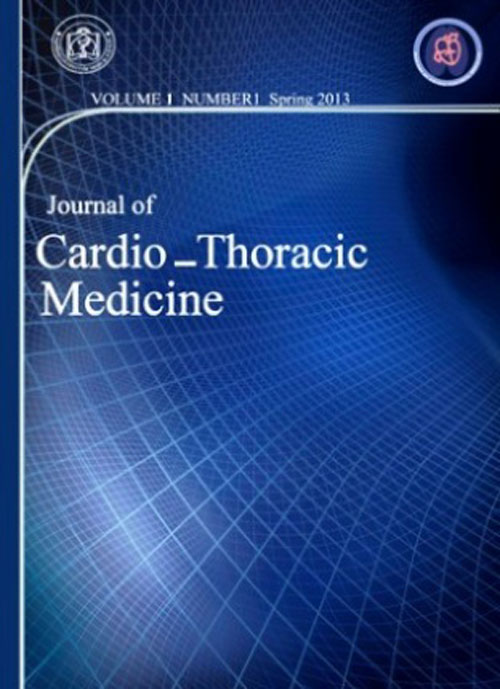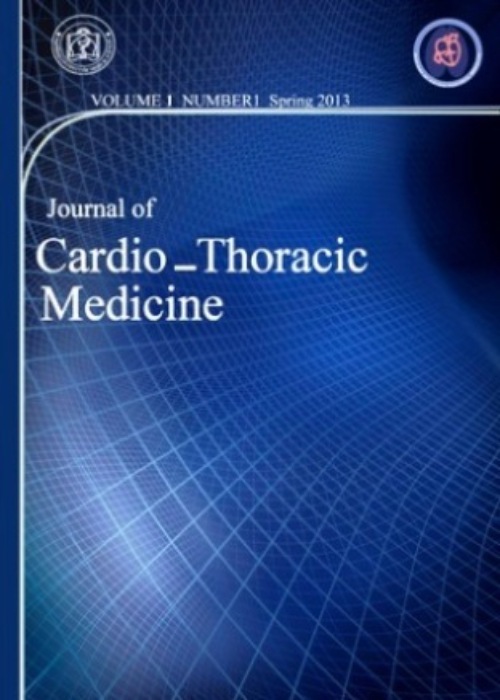فهرست مطالب

Journal of Cardio -Thoracic Medicine
Volume:4 Issue: 3, Summer 2016
- تاریخ انتشار: 1395/07/01
- تعداد عناوین: 8
-
-
Pages 465-467IntroductionIschemic preconditioning mediated by potassium channels is a physiological protective mechanism, . It is hypothesized that Nicorandil, which is a potassium channel activator, could protect the heart via preconditioning.Materials And MethodsThis clinical trial was conducted on 162 patients undergoing percutaneous coronary intervention (PCI) in Quem hospital, from Jan2013 to Jan 2014,patients divided into two groups. The first group received standard treatment plus Nicorandil (10 mg, twice daily) for three days before and after angioplasty. The second group received standard treatment after PCI.ResultsCardiac enzyme levels were significantly lower in the Nicorandil group at 6 and 12 hours after angioplasty,(p value=0.001) while no significant differences were observed in the symptoms and four-month prognosis of the study groups(p value=0.8).ConclusionIt is recommended that a randomized clinical trial be conducted for the close evaluation of the effects of Nicorandil on unstable angina patients.Keywords: Angioplasty, Nicorandil, Preconditioning
-
Pages 468-473IntroductionStudies on behavioral patterns and personality traits play a critical role in the prediction of healthy or unhealthy behaviors and identification of high-risk individuals for cardiovascular diseases (CVDs) in order to implement preventive strategies. This study aimed to compare personality types in individuals with and without CVD based on the enneagram of personality.Materials And MethodsThis case-control study was conducted on 96 gender-matched participants (48 CVD patients and 48 healthy subjects).Data were collected using the Riso-Hudson Enneagram Type Indicator (RHETI). Data analysis was performed in SPSS V.20 using MANOVA, Chi-square, and T-test.ResultsAfter adjustment for age and gender there is a significant difference between two groups (and male) in term of personality types one and five. In CVD patients, score of personality type one (F(1,94)=9.476) (P=0.003) was significantly higher, while score of personality type five was significantly lower (F(1,94)=6.231) (P=0.014), compared to healthy subjects. However, this significant difference was only observed in the score of personality type one in female patients (F(1,66)=4.382) (P=0.04).ConclusionIdentifying healthy personality type one individuals before CVD development, providing necessary training on the potential risk factors of CVDs, and implementation of preventive strategies (e.g., anger management skills) could lead to positive outcomes for the society and healthcare system. It is recommended that further investigation be conducted in this regard.Keywords: Cardiovascular Disease, Enneagram System, Personality Types, Iranian Population
-
Pages 474-479IntroductionPost cardiac surgery hemorrhagic syndromes, potentialized by implementing cardiopulmonary bypass, leads to increased hazards of blood products transfusion and pertains serious impacts on immediate patients outcome.
The objective of this clinical trial was to investigate the efficiency of exogenous fibrinogen to control hemorrhagic syndromes following cardiac surgery in the intensive care unit.Materials And MethodsEighty patients undergoing open heart surgery at Imam Reza Hospital, Mashhad, Iran with blood drainage more than 200 ml per hour were randomly divided to receive either fibrinogen 2 grams or placebo. The patients were investigated for amount of blood drainage, units of required blood product, length of stay in intensive care unit (ICU), and mortality.ResultsThe first early 3-hours drainage (443.97±169.98 vs 606.66±235.93ml; p value =0.001) and total first 24 hours drainage (1025.30 ml and 1377.60 ml; p value: 0.041) showed significant difference in favor of fibrinogen receiving group. The fibrinogen group required significantly lesser units of red blood cells, and fresh frozen plasma (FFP) (1.62 and 2.55) compared to placebo group (2.74 and 3.21) (p values: 0.010 and 0.032). Platelets units requirement did not reach significant difference between the groups. ICU length of stay was shorter in fibrinogen group (2.82 days versus 4.02 days; p value 0.045), while mechanical ventilation time did not significantly differ among the two groups. In addition, there was a trend towards decreased early mortality in fibrinogen receiving group (7.5% versus 17.5 % ; p value = 0.02).ConclusionAdministration of low dose of fibrinogen in patients with postoperative bleeding can reduce ongoing and total blood drainage, transfusion of blood products, ICU length and early mortality.Keywords: cardiac surgery, Fibrinogen, Postoperative Bleeding -
Pages 480-483IntroductionAlthough coronary endarterectomy is not an ideal procedure, it is the only available option for cardiac surgeons in some patients with diffuse coronary artery disease. Based on the majority of conducted studies, the results of coronary endarterectomy (including survival, graft patency, and recurrence of the symptoms of myocardial ischemia) are less prevalent than standard coronary artery bypass grafting. Generally, the left anterior descending artery (LAD) is the most commonly involved artery in coronary endarterectomy. The aim of this study was evaluate clinical and early results of Endarterectomy of LAD artery.Materials and MethodsIn total, 30 cases of coronary endarterectomy of the LAD were studied from January 2015 until January 2016.this is a retrospective study that Endarterectomy procedure was performed in Imamreza hospital of Mashhad university of medical sciences.ResultsThe mean age of the subjects was 63±4.5 years (range: 45-78 years). As the findings revealed, eighteen patients were male (60%), and the mean ejection fraction index was 43±5.1 (range: 15-60). Also, prior history of myocardial infarction was documented in 8 (26%) patients. The mortality rate among patients was estimated at 6.6% (n=2). In total, 12 (40%) and 7 (23%) patients required high-dose inotropic support and intra-aortic balloon pump, respectively. Risk of preoperative myocardial infarction was observed in 5 (16.5%) cases, and 3 (10%) patients required re-exploration due to significant hemorrhage.ConclusionIf coronary endarterectomy of the LAD is performed by experienced cardiac surgeons, favorable outcomes can be obtained.Keywords: CABG, Coronary Endarterectomy, Left Anterior Descending Artery
-
Pages 484-489IntroductionRheumatic heart disease still remains one of the leading causes of congestive heart failure and death owing to valvular pathologies, in developing countries. Valve replacement still remains the treatment of choice in such patients.The aim of this study wasto analyze the postoperative outcome of double valve replacement (Mitral and Aortic ) in patients of rheumatic heart disease.Materials And MethodsBetween 1988 and 2008, 300 patients of rheumatic heart disease underwent double (Mitral and Aortic) valve replacement with Starr Edwards valve or St Jude mechanical valve prosthesis were implanted. These patients were studied retrospectively for preoperative data and postoperative outcome including causes of early and late deaths and the data was analyzed statistically.ResultsThe 30-day hospital death rate was 11.3% andlate death occurred in 11.6%. Anticoagulant regimen was followed to maintain the target pro-thrombin time at 1.5 times the control value. The actuarial survival (exclusive of hospital mortality) was 92.4%, 84.6%, and 84.4%, per year at 5, 10, and 20 years, respectivelyConclusionsIn view of the acknowledged advantageof superior durability, increased thromboresistance in our patient population, and its cost effectiveness the Starr-Edwards ball valve or St. Jude valve is the mechanical prosthesis of choice for advanced combined valvular disease. The low-intensity anticoagulant regimen has offered suffcient protection against thromboembolism as well as hemorrhage.Keywords: Double Valve Replacement, Rheumatic Heart Disease, Starr Edwards Valve, St. Jude Valve
-
Pages 490-492Stanford type A acute aortic dissection (AAD) is a very rare complication, with potentially lethal consequences in pregnancy. In fact, pregnancy has been regularly associated with the possibility of aortic. dissection in almost half of young women. Herein, we present the case of a 38-year-old woman in her 37th week of pregnancy. The patients medical history was indicative of G4L2Ab1(4 gestaitions,2 lives, 1 abortion). She developed persistent chronic pain in the neck, chest, and back, without nausea or vomiting while waking in the morning. The computed tomography angiogram was indicative of AAD. The medical decision was to perform a combination of cesarean section under general anesthesia and median sternotomy for the open aortic valve. The term newborn showed an Apgar score of 9-10. The coronary arteries were preserved and the valve was repaired at commissural positions. Dacron supracoronary tube graft was attached to the aortic anastomotic site and subsequently to the aortic arch. The patient was discharged on day three after surgery with a good general condition. Moreover, the results indicated that she and one of her brothers suffered from Marfan syndrome.Keywords: Aortic Surgery_Type A Aortic Dissection_pregnancy
-
Pages 493-495Dobutamine stress echocardiography (DSE) has been widely used as a diagnostic and prognostic modality in the management of stress. DSE is associated with limited complications and adverse effects on the health of patients. In this case report, we described a 42-year-old female patient with dobutamine-induced coronary artery spasm with history of exertional dyspnea, which had deteriorated recently. No risk factors of coronary artery disease were observed in the patient, and she had previous non-diagnostic exercise tolerance test. DSE was performed on the patient, and at the end of the infusion rate of 30 mcg/min, retrosternal pain was detected. Standard 12-lead electrocardiogram was indicative of ST segment elevation in inferior leads. Moreover, echocardiographic imaging of the patient revealed concomitant akinesia in the right coronary artery. On the other hand, subsequent coronary angiograms showed only mild coronary atherosclerosis.Keywords: Coronary Spasm, Dobutamine, Stress Echocardiography
-
Pages 496-496Herein, we present the case of a 45-year-old woman with pulsion and midesophageal diverticula, who had complaints of dysphagia and regurgitation. Diagnosis was confirmed by endoscopy and barium swallow. The patient underwent right posterolateral thoracotomy with excision of diverticula and repair of the muscular layer along the site of diverticula. Five days following the operation, barium swallow with the passage of the contrast material through distal esophagus showed no diverticula. After five months, the patient remained asymptomatic.Keywords: Dysphagia, Esophageal Diverticula, Endoscopy, Thoracotomy


